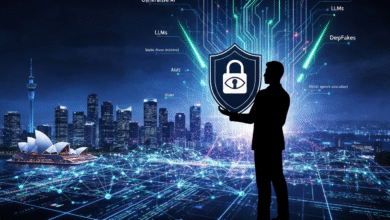Insights from Top Leaders on Cybersecurity Awareness Month 2025

▼ Summary
– Cyber Security Awareness Month 2025 concluded with strong support from the Australian government and companies, emphasizing the global impact of cybersecurity breaches.
– Recent major cyber incidents at organizations like Qantas and AustralianSuper highlight the rapidly evolving threat landscape in Australia.
– Elastic’s security director stressed the need for proactive cybersecurity measures, centralized data analysis, and strong identity management to counter immediate threats.
– Multiple experts emphasized that cybersecurity is a cultural issue requiring workforce engagement, trust-building, and shared accountability across organizations.
– Cybermindz.org reframed cybersecurity burnout as an operational risk, advocating for mental resilience programs and leadership accountability for team wellbeing.
As October draws to a close, so does the 2025 Cybersecurity Awareness Month, a period that has seen unprecedented engagement from Australian organizations and government bodies. This heightened focus comes at a crucial time, with recent high-profile breaches affecting major entities like Qantas, Western Sydney University, and AustralianSuper underscoring the rapidly changing threat environment. The Australian Signals Directorate championed this year’s theme, “Building our cyber safe culture,” emphasizing that cybersecurity is a continuous responsibility rather than a yearly observance.
Industry leaders from Elastic, Smartsheet, HCLTech, and Cybermindz.org have shared critical perspectives on strengthening defenses and fostering resilience.
Elastic’s Director of Security for ANZ, Harry Chichadjian, pointed to cloud identity as a major vulnerability. He stressed that threat actors now execute attacks immediately, leaving little time for reaction. Chichadjian advocates for a centralized data platform to detect anomalies quickly and warns that relying only on signature-based tools is insufficient against AI-driven threats. He emphasized, “The cost of waiting is far higher than the cost of acting.”
Ravi Soin, Chief Information Security Officer at Smartsheet, highlighted organizational culture as a primary defense. He explained that security must be seen as a business enabler, not a barrier. By building trust and shared accountability, companies can shift from perimeter-based security to a model where every user plays a role. Soin noted, “Security isn’t just about preventing incidents—it’s about enabling growth with confidence.”
Sonia Eland of HCLTech echoed the cultural theme, noting that even advanced technology can be undermined by human error. She called for embedding security into daily behavior and praised diverse teams for reducing blind spots. Eland stated, “A truly cyber-resilient future will be achieved by people—united by shared responsibility and empowered by knowledge.”
Peter Coroneos, Founder of Cybermindz.org, addressed the human toll of cybersecurity roles, framing burnout as an operational risk. He reported that fatigue impairs decision-making and situational awareness, making mental resilience as critical as technical controls. Coroneos urged organizations to integrate well-being into risk management, observing that recovery programs yield measurable benefits in stress reduction and cognitive function.
The Australian Signals Directorate wrapped up the month by encouraging ongoing vigilance. They reported an 8% rise in individual cybercrime costs and recommended simple but effective habits—installing updates, using strong passphrases, and enabling multi-factor authentication. Their new Cyber Health Check tool offers a practical way for Australians to assess their security posture.
A video discussion with Chief Information Security Officers from multiple states reinforced the message of shared responsibility. Featuring leaders like Stephanie Crowe and Marie Patane, the conversation detailed actionable steps for government, industry, and individuals to collectively strengthen Australia’s cyber resilience.
(Source: ITWire Australia)
